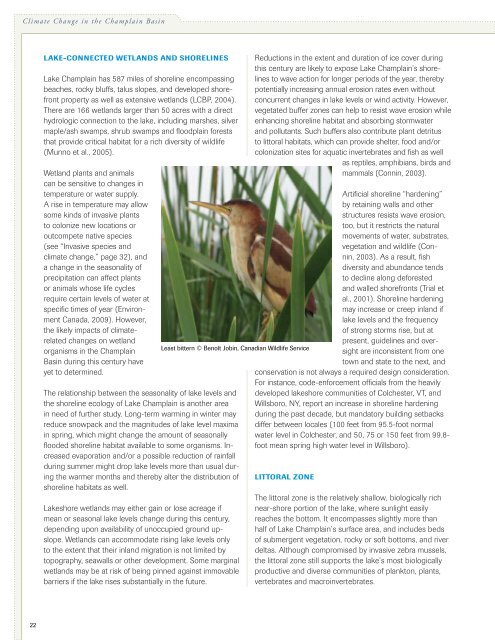Climate Change in the Champlain Basin - The Nature Conservancy
Climate Change in the Champlain Basin - The Nature Conservancy
Climate Change in the Champlain Basin - The Nature Conservancy
Create successful ePaper yourself
Turn your PDF publications into a flip-book with our unique Google optimized e-Paper software.
<strong>Climate</strong> <strong>Change</strong> <strong>in</strong> <strong>the</strong> Champla<strong>in</strong> Bas<strong>in</strong>Lake-connected wetlands and shorel<strong>in</strong>esLake Champla<strong>in</strong> has 587 miles of shorel<strong>in</strong>e encompass<strong>in</strong>gbeaches, rocky bluffs, talus slopes, and developed shorefrontproperty as well as extensive wetlands (LCBP, 2004).<strong>The</strong>re are 166 wetlands larger than 50 acres with a directhydrologic connection to <strong>the</strong> lake, <strong>in</strong>clud<strong>in</strong>g marshes, silvermaple/ash swamps, shrub swamps and floodpla<strong>in</strong> foreststhat provide critical habitat for a rich diversity of wildlife(Munno et al., 2005).Wetland plants and animalscan be sensitive to changes <strong>in</strong>temperature or water supply.A rise <strong>in</strong> temperature may allowsome k<strong>in</strong>ds of <strong>in</strong>vasive plantsto colonize new locations oroutcompete native species(see “Invasive species andclimate change,” page 32), anda change <strong>in</strong> <strong>the</strong> seasonality ofprecipitation can affect plantsor animals whose life cyclesrequire certa<strong>in</strong> levels of water atspecific times of year (EnvironmentCanada, 2009). However,<strong>the</strong> likely impacts of climaterelatedchanges on wetlandorganisms <strong>in</strong> <strong>the</strong> Champla<strong>in</strong>Bas<strong>in</strong> dur<strong>in</strong>g this century haveyet to determ<strong>in</strong>ed.Least bittern © Benoît Job<strong>in</strong>, Canadian Wildlife Service<strong>The</strong> relationship between <strong>the</strong> seasonality of lake levels and<strong>the</strong> shorel<strong>in</strong>e ecology of Lake Champla<strong>in</strong> is ano<strong>the</strong>r area<strong>in</strong> need of fur<strong>the</strong>r study. Long-term warm<strong>in</strong>g <strong>in</strong> w<strong>in</strong>ter mayreduce snowpack and <strong>the</strong> magnitudes of lake level maxima<strong>in</strong> spr<strong>in</strong>g, which might change <strong>the</strong> amount of seasonallyflooded shorel<strong>in</strong>e habitat available to some organisms. Increasedevaporation and/or a possible reduction of ra<strong>in</strong>falldur<strong>in</strong>g summer might drop lake levels more than usual dur<strong>in</strong>g<strong>the</strong> warmer months and <strong>the</strong>reby alter <strong>the</strong> distribution ofshorel<strong>in</strong>e habitats as well.Lakeshore wetlands may ei<strong>the</strong>r ga<strong>in</strong> or lose acreage ifmean or seasonal lake levels change dur<strong>in</strong>g this century,depend<strong>in</strong>g upon availability of unoccupied ground upslope.Wetlands can accommodate ris<strong>in</strong>g lake levels onlyto <strong>the</strong> extent that <strong>the</strong>ir <strong>in</strong>land migration is not limited bytopography, seawalls or o<strong>the</strong>r development. Some marg<strong>in</strong>alwetlands may be at risk of be<strong>in</strong>g p<strong>in</strong>ned aga<strong>in</strong>st immovablebarriers if <strong>the</strong> lake rises substantially <strong>in</strong> <strong>the</strong> future.Reductions <strong>in</strong> <strong>the</strong> extent and duration of ice cover dur<strong>in</strong>gthis century are likely to expose Lake Champla<strong>in</strong>’s shorel<strong>in</strong>esto wave action for longer periods of <strong>the</strong> year, <strong>the</strong>rebypotentially <strong>in</strong>creas<strong>in</strong>g annual erosion rates even withoutconcurrent changes <strong>in</strong> lake levels or w<strong>in</strong>d activity. However,vegetated buffer zones can help to resist wave erosion whileenhanc<strong>in</strong>g shorel<strong>in</strong>e habitat and absorb<strong>in</strong>g stormwaterand pollutants. Such buffers also contribute plant detritusto littoral habitats, which can provide shelter, food and/orcolonization sites for aquatic <strong>in</strong>vertebrates and fish as wellas reptiles, amphibians, birds andmammals (Conn<strong>in</strong>, 2003).Artificial shorel<strong>in</strong>e “harden<strong>in</strong>g”by reta<strong>in</strong><strong>in</strong>g walls and o<strong>the</strong>rstructures resists wave erosion,too, but it restricts <strong>the</strong> naturalmovements of water, substrates,vegetation and wildlife (Conn<strong>in</strong>,2003). As a result, fishdiversity and abundance tendsto decl<strong>in</strong>e along deforestedand walled shorefronts (Trial etal., 2001). Shorel<strong>in</strong>e harden<strong>in</strong>gmay <strong>in</strong>crease or creep <strong>in</strong>land iflake levels and <strong>the</strong> frequencyof strong storms rise, but atpresent, guidel<strong>in</strong>es and oversightare <strong>in</strong>consistent from onetown and state to <strong>the</strong> next, andconservation is not always a required design consideration.For <strong>in</strong>stance, code-enforcement officials from <strong>the</strong> heavilydeveloped lakeshore communities of Colchester, VT, andWillsboro, NY, report an <strong>in</strong>crease <strong>in</strong> shorel<strong>in</strong>e harden<strong>in</strong>gdur<strong>in</strong>g <strong>the</strong> past decade, but mandatory build<strong>in</strong>g setbacksdiffer between locales (100 feet from 95.5-foot normalwater level <strong>in</strong> Colchester, and 50, 75 or 150 feet from 99.8-foot mean spr<strong>in</strong>g high water level <strong>in</strong> Willsboro).Littoral zone<strong>The</strong> littoral zone is <strong>the</strong> relatively shallow, biologically richnear-shore portion of <strong>the</strong> lake, where sunlight easilyreaches <strong>the</strong> bottom. It encompasses slightly more thanhalf of Lake Champla<strong>in</strong>’s surface area, and <strong>in</strong>cludes bedsof submergent vegetation, rocky or soft bottoms, and riverdeltas. Although compromised by <strong>in</strong>vasive zebra mussels,<strong>the</strong> littoral zone still supports <strong>the</strong> lake’s most biologicallyproductive and diverse communities of plankton, plants,vertebrates and macro<strong>in</strong>vertebrates.22
















